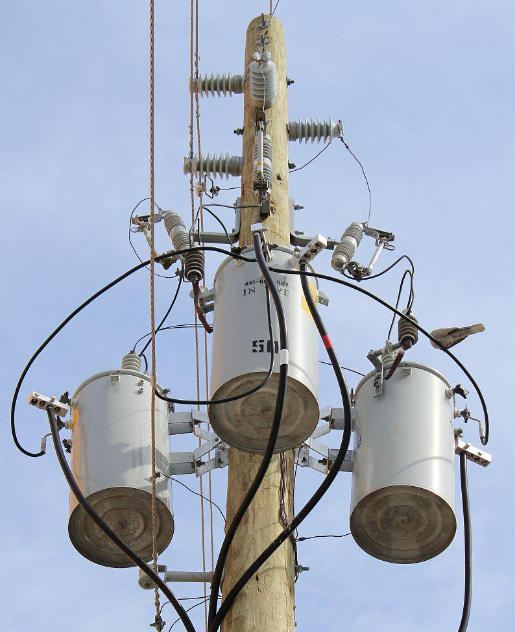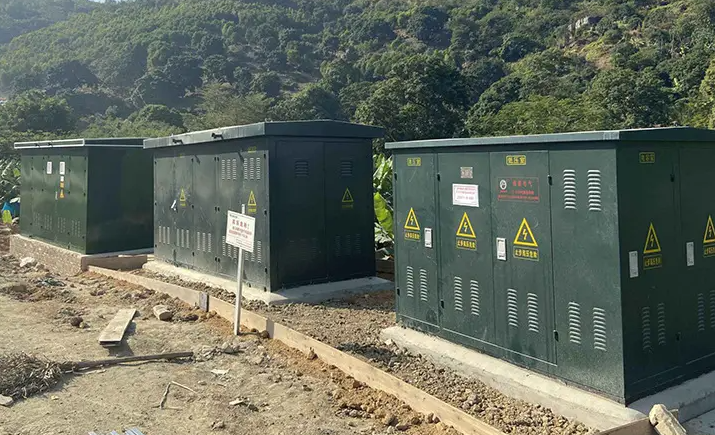What is a pole-mounted transformer?
Pole-mounted transformers are installed on telephone poles, usually found in rural or residential areas, and are generally small transformers.
Some of the main features of pole mounted transformers are as follows:
- Elevation: Pole-mounted transformers are elevated above the ground, reducing the risk of damage from flooding or standing water during adverse weather conditions.
- Accessibility: They are mounted on poles for easy maintenance and repair as line workers can reach them using bucket trucks.
- Cost-Effectiveness: Due to simpler infrastructure requirements, the installation of pole-mounted transformers is generally more cost-effective compared to pad-mounted transformers. In this day and age, these units are also generally cheaper to purchase.
Aesthetics: Pole-mounted transformers are less visually intrusive than pad-mounted transformers, but can also be viewed as the opposite. More and more often we see communities moving to places where all the utilities are buried. Then there would be no telephone poles.
Pad-Mounted Transformers Description
Pad-type transformers, on the other hand, are mounted on a concrete pad or encl  osure in the ground and are common in cities and densely populated areas. These transformers serve the same purpose as pole mounted transformers.
osure in the ground and are common in cities and densely populated areas. These transformers serve the same purpose as pole mounted transformers.
Some of the main features of pad type transformers are as follows:
- Space Efficiency: Pad-mounted transformers are designed to take up minimal space, making them ideal for locations where space is limited or where underground distribution lines are common.
- Reduced noise: Since pad-mounted transformers are located on the ground, they produce less noise than pole-mounted transformers, which is a significant advantage in residential areas.
- Aesthetics: While they may look bulkier than pole-mounted transformers, in some setups their pad-mounting is still more visually appealing.
- Environmental Protection: The grounded and enclosed nature of the pad transformer provides enhanced protection against accidental contact, reducing potential safety hazards.1) The difference between pad mounted and prefabricated wiring modes:
pad mounted transformer generally has one or two 10KV incoming lines and low-voltage outgoing cables. Four to six lines have a single transformer, and the transformer capacity is generally 500KVA to 800KVA. When the prefabricated transformer is a single distribution transformer, there are two 10KV incoming lines. The capacity of a single transformer is generally 500KVA~800KVA, and the low-voltage outgoing cables are generally 4~6. With two distribution transformers, there are two 10KV incoming lines. The capacity of each transformer is 500KVA~800KVA, and the low-voltage outgoing cables are generally 8~12 lines.
2) The distinction between main internal components of pad mounted and prefabricated transformers:
pad mounted transformer is generally composed of transformer, 10KV loop network switch, 10KV cable plug, low-voltage pile head box and other main components. The utility model has the advantages of small volume, low cost and easy installation. European box type transformer is mainly composed of transformer, 10KV ring network switch cabinet, low-voltage capacitor, low-voltage switch and other main components, which is equivalent to compact installation of equipment in type III station in metal box, so as to miniaturize type III station. The volume of prefabricated transformer substation is higher than that of pad mounted transformer substation, and the cost is also higher than that of pad mounted transformer substation.
3) Advantages and disadvantages of pad mounted and prefabricated transformers:
The advantages of pad mounted transformer substation are small size, small floor area, easy placement, convenient camouflage, and easy to coordinate with the environment of the residential area. It can shorten the length of low-voltage cable, reduce line loss, and reduce the cost of power supply. The disadvantages of pad mounted transformer are low reliability of power supply; Without electric mechanism, it is impossible to add distribution automation device; No capacitor device, which is bad for reducing line loss; The noise is higher than Type III and Type V stations, because Type III and Type V stations place transformers indoors for sound insulation; In addition, the centralized electromagnetic radiation of type III and type V stations is decomposed into multipoint radiation; Due to the different civil foundations of box type transformers with different capacities, it is inconvenient to increase the capacity of box type transformers; When the box type transformer substation is overloaded or the user increases its capacity, the civil engineering needs to be rebuilt, which will result in a longer power failure time and increase the difficulty of the project.

